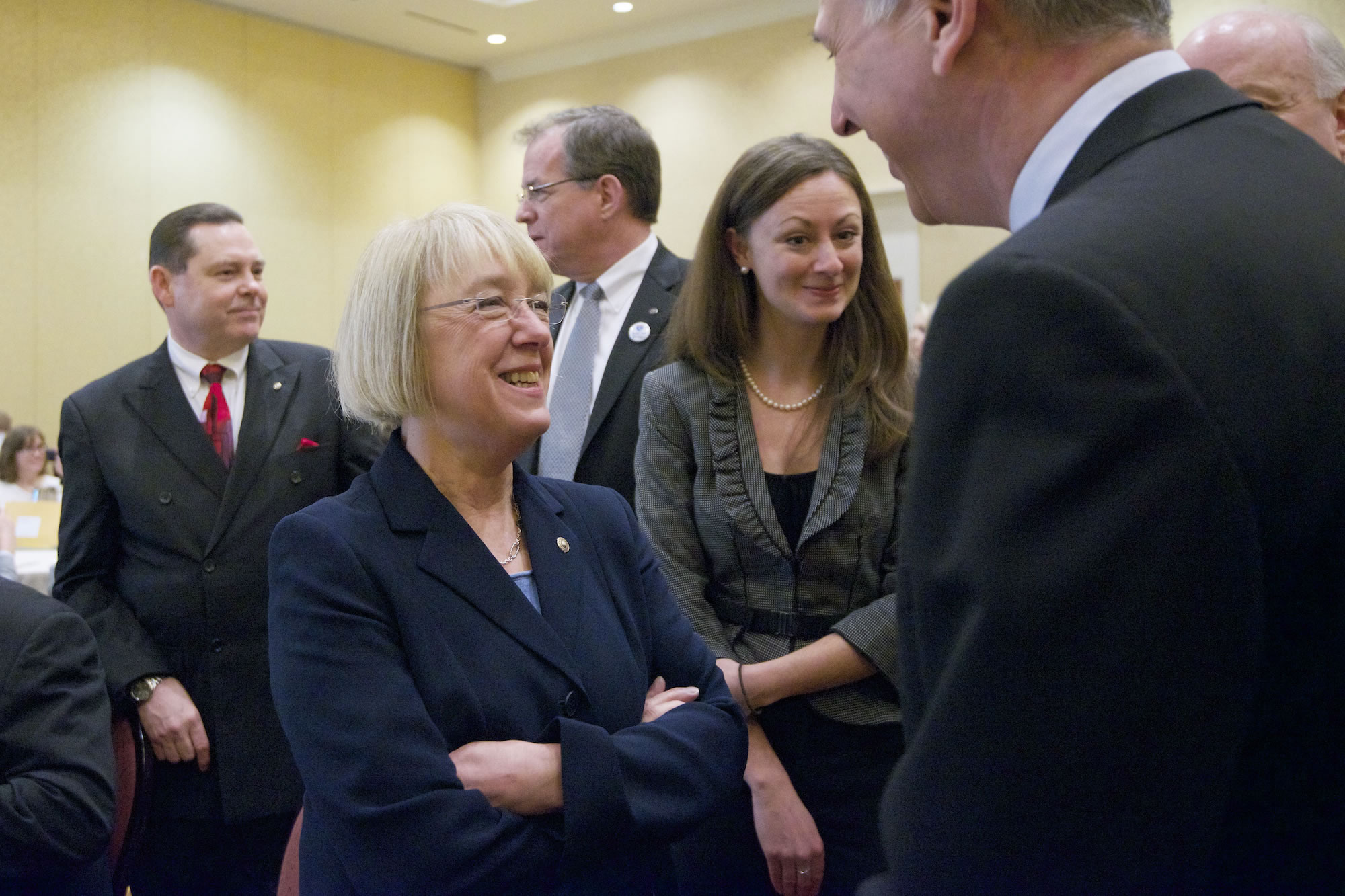U.S. Sen. Patty Murray on Thursday sharply criticized the decision by two Clark County commissioners to pull funding from the county’s largest economic development group, saying “those who wield their influence by turning their backs on organizations that grow jobs in this community are turning their backs on the region itself.”
Murray, D-Wash., did not call out Republican Commissioners David Madore and Tom Mielke by name. But she was unmistakably referring to their decision last month to halt county government’s funding of the Columbia River Economic Development Council, unless it drops its support for the Columbia River Crossing project, a replacement Interstate 5 bridge that includes light rail.
Murray, who chairs the Senate Budget Committee, made her remarks during the CREDC’s quarterly luncheon event, held at the Hilton Vancouver Washington and attended by an estimated 175 people. The event featured a keynote speech by Washington State University Vancouver Chancellor Mel Netzhammer.
Speaking before Netzhammer’s presentation, Murray said the CRC is “the single biggest investment we can make in this region’s economic future,” a remark that prompted loud and lengthy applause from attendees. Attempts to reach Mielke were unsuccessful Thursday. In a phone interview, Madore fired back on several fronts, saying he would support the CREDC if it was actually carrying out its core mission instead of supporting the CRC, which “kills the economic development of the Columbia River freight corridor” by reducing the bridge’s height, which he said destroys existing businesses and jobs.
Murray’s remarks came amid a flurry of recent actions concerning the CRC, including state and local measures advanced by proponents and critics, in a community divided over the controversial $3.5 billion, bi-state proposal to replace the I-5 bridge, extend light rail into Vancouver and rebuild the freeway on both sides of the Columbia River.
‘No plan is perfect’
The hard truths, Murray said, are clear: “A light rail component is absolutely necessary to secure federal funding for this project,” local revenues and tolling will be needed and “any further attempt to change the current bridge design will cause years, if not decades of delay.”
The notion that light rail is required to build the CRC is “really a deception,” Madore countered in a phone interview. “The bridge is the candy coating,” he added. “Light rail is the poison they’re trying to get us to swallow.”
In an interview with The Columbian after the CREDC’s event, Murray said “we will have a full funding grant agreement” to pay for light rail as part of the CRC. When asked later whether she thought that funding agreement would happen this year, Murray, in an emailed statement sent by her office, replied that landing the funding “this year is crucial to the future of the CRC project and our regional economy, but it requires a financial commitment from our partners in both (the Washington and Oregon) state legislatures. I am determined to move this project forward, but it won’t happen without funding from both Salem and Olympia.”
Legislatures in Washington and Oregon are grappling over proposals to chip in a combined $900 million to help pay for the CRC project. The finance plan also calls for federal money and up to $1.3 billion in tolling revenue. Last week, Madore and Mielke voted to officially position the county against the CRC, adopting a resolution to that end. Meanwhile, an anti-light rail group is pressing a case in court in hopes of putting to a vote a measure asking Vancouver residents to prohibit city resources from being used to extend TriMet’s MAX line from Portland to Vancouver as part of the CRC project.
Stepping into the fray Thursday, Murray said “no plan is perfect” but the CRC plan “has been agreed upon and studied time and time again.”
The era when the federal government could single-handedly build a project like the CRC is over, Murray added, so “what’s needed today are rock-solid partnerships at the local level.”
She went on, “And that is why I’m so disappointed in the recent action to defund the CREDC.”
Madore said one reason he moved to halt the county’s two-year, $200,000 contract with the CREDC was because he didn’t want taxpayer dollars going to an agency that has supported a “light-rail tolling project” which voters rejected when they defeated, in November, a sales tax increase to help pay for light rail maintenance and operations. Others say the vote was about the funding mechanism to help pay for light rail, not about the larger merits of the CRC project. In her remarks Thursday, Murray said those who are choosing to ignore “the needs of this community” are putting the region “at real risk of being passed over for the critical investments it so desperately needs.”
Murray said other communities in Washington state and across the United States are taking a different path and “presenting unified support behind road and bridge projects.”
’21st Century University’
Netzhammer, the WSUV chancellor, delivered the keynote address — “The 21st Century University and WSU Vancouver” — during the CREDC’s quarterly event.
Netzhammer, who’s six months into his first year at WSUV, said the university wants to increase degree attainment in Southwest Washington. To that end, he said, WSUV is in the early stages of a “needs assessment” that will examine student demand, employer needs and workforce trends to help officials decide where to expand program offerings and where to increase the capacity of current programs.
Netzhammer also spelled out five major issues in higher education: cost of attendance; quality and accountability; access; disruptive technology; and community engagement.
He said tuition, fees and costs of textbooks are all going up, noting that the decrease in state aid across the country is being compensated by increases in tuition. He displayed several data-filled charts, including one showing that student loan debt is now higher than credit card debt.
He spoke of the value of possessing a bachelor’s degree or higher, saying that “even during the worst of the recession” the number of jobs for those with baccalaureate degrees increased by roughly 3 percent a year.
Netzhammer said he hopes there’s no tuition increase this year. He said the cornerstone of the university’s $20 million capital campaign — of which it’s raised $13 million so far — is supporting scholarships. About $4 million of the $13 million raised so far is for scholarship support, he said.




